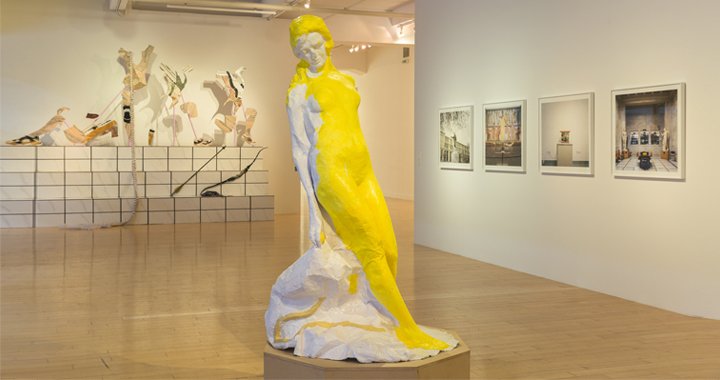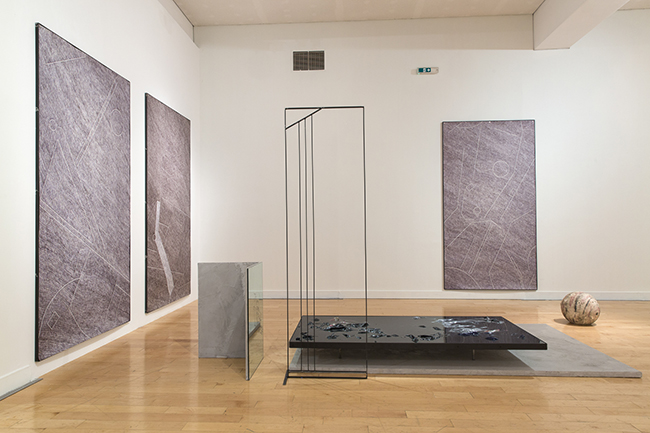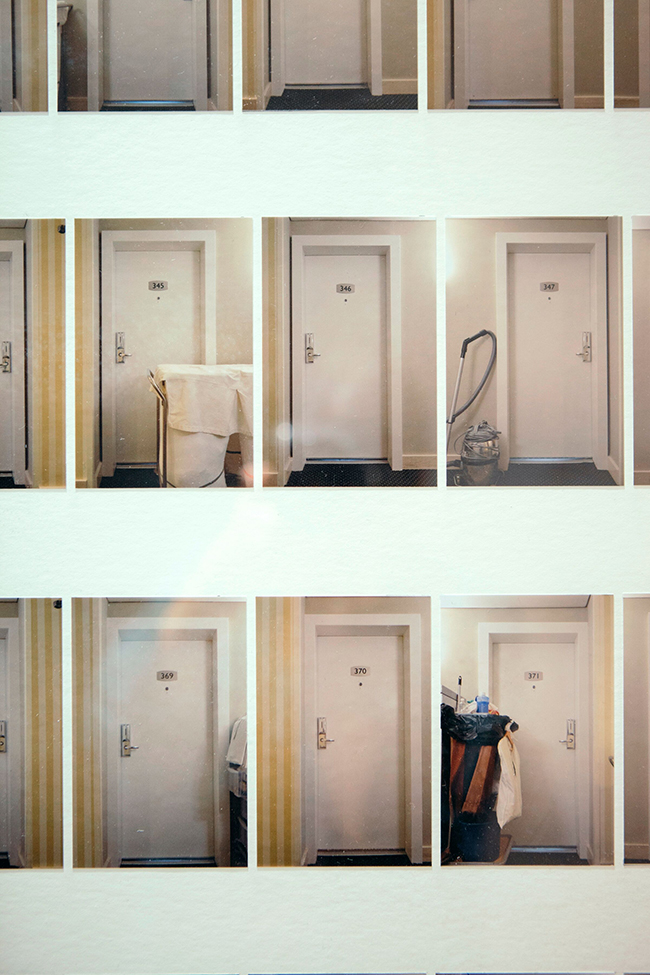
A subjectively objective hallucination of Athens
17/07/2019
The exhibition The Same River Twice – which can be currently seen at the Benaki Museum in Athens (through September 22) and was organised in cooperation with the Athens-based DESTE Foundation and the New Museum in New York – endeavors to do the impossible: namely, create the portrait of a city well knowing that, by the time the portrait is officially finished, the city will have already changed. This quixotic intention is already labeled as such in the title of the exhibition based on the legendary dictum of the Greek philosopher Heraclitus: ‘No man ever steps in the same river twice, for it’s not the same river and he’s not the same man.’ 31 artists are participating in the show, all of whom were either born in Athens or now call it their home. The youngest artist was born in 1991, whereas the oldest was born in 1938. The Same River Twice is a story of interpretations and frozen moments in time; of how the past influences the present day and how it can influence the future; of how the meanings of various things, including symbols, have changed over time. Each of the artists has attempted to highlight their own thread in the warp and weft of today’s Athens, which itself is like a gigantic patchwork quilt of centuries of civilisation in which fine and intricate fabric pieces are intermingled with patches made from rougher and coarser woven cloth. The overall view is one of a colourful vibrancy edged with rags. In a sense, the exhibition is like a hallucination of Athens as presented through the prism of a myriad of artists – subjectively objective; authentic, but at the same time, fictional.
It would be a stretch to call Athens beautiful in the classical sense of the word. The architecture of the city is eclectic, creating the feeling that it is developing chaotically and without any supervision. In addition, it boasts an untamed spirit of anarchy – there’s graffiti everywhere, literally transforming the facade of almost every other building into a canvas. All of this modern-day chaos makes for a surreal interaction with the regal citadel of the Acropolis, which rises above the disarray below it and contains the ultimate symbol of architectural beauty – the Parthenon.

Installation View, The Same River Twice: Contemporary Art in Athens, Benaki Museum / Pireos 138, Athens (June 21–Sept. 22, 2019). Photo: Eftychia Vlachou
‘The economic crisis is over’ can be heard from many an Athenian, and the claim that Athens is currently seething (in the most direct sense of the word) can be observed even with an eye that is unversed in the socio-economic intricacies of the city. A similar boom is being experienced by the Athens art scene, undeniably boosted by the divisively critiqued Documenta 14 of 2017, which, among other things, gave stimulus to the current upsurge in local art residencies and the cliched relabeling of Athens as ‘the new Berlin’ (as utopian and absurd a stereotype as any).
The Same River Twice is the conceptual continuation of the DESTE Foundation and the New Museum’s 2016 exhibition The Equilibrists, also held at the Benaki Museum. Back then, the focus was on the future – 33 young Greek artists (in their 20s and 30s) who currently live scattered around the globe. They were a part of the ‘young precariat’ generation that has grown up in a politically, socially and economically unstable environment. The Equilibrists was a telling of their views and the challenges that they face in a world that is becoming ever more complicated with every passing day, to the point where it could be seriously likened to juggling while walking a tightrope.
‘This exhibition is very different,’ says Dakis Joannou, president of the DESTE Foundation as well as patron of the arts, collector, and the originator of both exhibitions. ‘The first time we had young kids from all over the world – from Athens, Berlin, Cyprus... This year the formula is different. All of the artists are based in Athens, and they are of all ages. They are “capturing the moment” of Athens – it's creativity, it's multifaceted art scene; they’re documenting the crisis, gender issues and so on. The two exhibitions had very different formulas, yet they are united in their goal – to create a platform for Greek art.’
Incidentally, The Same River Twice is also a wonderful guide to how to look at your city (if you’re an Athenian) from a completely different point of view than usual, while for visitors, it makes the discovery experience even more interesting. After all, history itself is, up to a point, art – the life art of civilisations.
The following are short descriptions of just seven of the works illustrating Athens as seen by artists who live there.
Rena Papaspyrou. Photocopies Directly from Matter, 1980-82

Rena Papaspyrou, Photocopies Directly from Matter, 1980-82. 291 black and white photocopies. Collection by National Museum of Contemporary Art, Athens. Photo: Maria Maneta
Rena Papaspyrou was born in Athens in 1938, and is the oldest artist showing her work in the exhibition. In her work, she illustrates the ever-changing urban landscape by using a variety of urban materials – parts of walls, doors, window jambs, dust, shards, and other ‘architectural’ impressions of urban life sourced from archaeological excavations or that she has simply found...pieces of the puzzle of time, most of which remain unnoticed as people rush through their days. Having collected them, Papaspyrou forms meditative collages – urban ‘episodes’ that encourage one to think about time, its ever-forward march, and one’s presence in it. Moreover, it’s an invitation to take a closer look and see, right in front of our eyes, the stories, novels and poems hidden in the city's thick patina of both history and time.
Vangelis Vlahos. Intercontinental (Athens, 1999), 2017

Vangelis Vlahos, Intercontinental (Athens, 1999), 2017 (detail). Six boards with photographs. Photo: Eftychia Vlachou
Vangelis Vlahos has always been interested in the interaction and confrontation that goes on between architectural, political and economic languages. His work Intercontinental documents the doors to the rooms of the city’s legendary luxury hotel, the Athenaeum InterContinental Athens, at different times of the day. The photographic story is complemented by a portfolio of politicians and publicly known people who stayed at the hotel in 1999 – the year of the terrorist incident that took place on the evening before an international business conference and in which a bomb explosion killed one woman and injured another person. The Revolutionary Cells group, which had previously carried out bomb explosions in various public institutions, also claimed responsibility for this one. In this piece, Vlahos uses the door as a symbol that stands between the public and the private, the visible and the invisible, the said and the unsaid, and between reality and fiction.
Dionisis Kavallieratos, Philosophers forming a human pyramid, 2014

Dionisis Kavallieratos, Philosophers Performing a Human Pyramid, 2014. Glazed ceramic, bronze, copper, 120x160x40 cm. Photo: Boris Kirpotin, Athens
Athenians have always had the ability to look at their history, myths and religion with a healthy dose of wit. The work of Dionisis Kavallieratos plays out an irony-filled mise-en-scène with 36 renowned philosophers. By placing these reputable minds ‘on all fours’, Kavallieratos has built a kind of temporary human monument from glazed ceramic pottery. At the very top is Diogenes, who is famous for, among things, practicing everything that he preached. Namely, he preferred to live in poverty and fought against the system of artificially constructed values of a corrupt society; he also always ate in the market square, which is something that other Athenians never did, and could often be seen carrying a lighted lamp – even on the brightest of days – and saying: ‘I am just looking for an honest man.’ In the second row from the top are Nietzsche and Descartes, and in the third: Socrates, Foucault, and Epicurus. In the fourth row: Russell, Hume, Bacon, Locke. Fifth row: Hegel, Krishnamurti, Plato, Chomsky, and Kant. Sixth row: Zeno of Citium, Derrida, Aristotle, Confucius, de Beauvoir, and Wittgenstein. Seventh row: Marx, Engels, Bentham, Rousseau, Camus, Sartre, and Schopenhauer. Eighth row: Democritus, Machiavelli, Laozi, Thales, Hypatia, Pythagoras, Spinoza, and Heraclitus. The images of all of these reputable founders of various philosophies are finely glazed except for one – the founder of the school of stoicism, Zeno of Citium. And, while almost all of the figures gaze into the distance while facing straight ahead, Heraclitus is the only outlier – he has turned his head to the left and, with his elbow on a globe, supports his chin in his hand. Kavallieratos has also taken care to make the ‘backside’ of the work amusing – the name of each philosopher is neatly written on his or her bum...
Born in Athens in 1979, Kavallieratos lives and works in both Berlin and Athens.
Angelos Papadimitriou. Farewell Art, 1991-92

Angelos Papadimitriou. Farewell Art, 1991-92. Iron, oil, acrylic paint and canvas, 2010 x 170 cm. Courtesy of D. Daskalopoulos Collection. Photo: Nikos Markou
Angelos Papadimitriou is a standout on the Greek art scene – an eccentric and versatile character who is equally skilled at being a sculptor, painter, singer and actor. His works overflow with allegorical compositions and mythological references, and they lack neither humor nor elements of the grotesque. Farewell Art is a vertical painting that the artist himself slowly rotates...turning and churning just like the river of life. Mythological narratives intermingle with intimate scenes of lovers, graphic elements, and abstractions. The work was presented for the first time at the 1993 Venice Biennale.
Pavlos Fysakis. The Dolls (1996-97)

Pavlos Fysakis. 3k085k305k09, from The Dolls series (1996). Black and white photograph, 69 x 34.5 cm. Photo: Pavlos Fysakis
Photographer Pavlos Fysakis focuses on unusual narratives and places that are not commonly labeled on traditional maps. He is interested in boundaries: boundaries that are crossed by some but not others; generally accepted boundaries and boundaries created by societal stereotypes; boundaries that divide ‘the welcome’ from ‘the unwelcome’. The Dolls series of photographs was created from 1996 to 1997 at the Dolls night club at which transsexuals would perform the cabaret act. By becoming a frequent visitor, Fysakis gained the performers’ trust and was allowed to photograph them for a whole year, both on stage and backstage in their dressing rooms. ‘I admired their courage: they had taken their lives into their hands, against all odds. I wondered, how does one define oneself? What is the process for a new identity to be born?’ says the artist. Now the Koukaki neighbourhood of Athens where the Dolls night club once stood has been gentrified, with Airbnb even having ranked it in 2017 as being among the five most interesting neighbourhoods in the world in which to stay.
Nikolas Ventourakis, Leaving Utopia: R2, 2019

Nikolas Venturakis, Billboard 1, from the Leaving Utopia series, 2013. C-type print, Dibond, frame, anti-reflective glass. 121.9 x 101.6 cm
Nikolas Ventourakis lives and works between Athens and London. His signature style could also be described as being ‘in between’, in this case, on the threshold between art and documentation, leaving the viewer to decide on which side they wish to find themselves. In the photographic series Leaving Utopia, Ventourakis appears to capture authentic pieces of Athens: the facades of houses, people, the city’s skyline. The series delineates a narrative but leaves almost infinite room for interpretation. Ventourakis began his work on Leaving Utopia during the economic crisis, when the old, pre-crash advertising billboards depicting a preponderance of goods and services posted throughout the city seemed to be the only witnesses to the economic prosperity that once lived in the empty shop windows being captured by Ventourakis’ camera.
Lakis and Aris Ionas / The Callas, 2008-2019

Lakis & Aris Ionas / The Callas, Dance Me to the End, 2010. Embroidered tapestry and live performance by The Callasettes. tapestry: 80 x 30 cm. Courtesy of the artists
The installation made by the multimedia artist association The Callas, founded by brothers Lakis and Aris Ionas, is the final work on view in the exhibition. The Callas is a creative team that works with music, films, magazines and works of art, as well as exhibitions and various events. The British newspaper The Independent has called them ‘a cross between punk rock and Andy Warhol's Factory scene.’ They have performed in churches, apartments, mountains, on ships and in toilets, and at Liverpool Psyche Festival (Liverpool UK), The Great Escape Festival (Brighton, UK), Indigenes Festival (France), and Reeperbahn Festival (Hamburg, Germany), among others. For more than a decade, Lakis & Aris have also released notable magazines on the Athens underground music/art/film scene, such as Velvet Magazine and Lust. Their studio is one of the most active cultural spaces in Athens. Their first feature film, LUSTLANDS (HAOS film), premiered at the 7th Athens Avant-Garde Film Festival, whereas their second film, The Great Eastern, premiered at Documenta 14.
The multimedia installation at The Same River Twice resembles a stage that has been built in the middle of nowhere. It’s a vibrant mix of romanticism with elements of psychedelia and the melancholy of punk. In a way, it's like a mass of lava pulsating in the creative crater of Athens that, every once in a while, bursts into new vibrations and erupts. The Callas has also created an embroidered work especially for this exhibition, as well as a song inspired by the title of the exhibition.

Installation View, The Same River Twice: Contemporary Art in Athens, Benaki Museum / Pireos 138, Athens (June 21–Sept. 22, 2019). Photo: Eftychia Vlachou